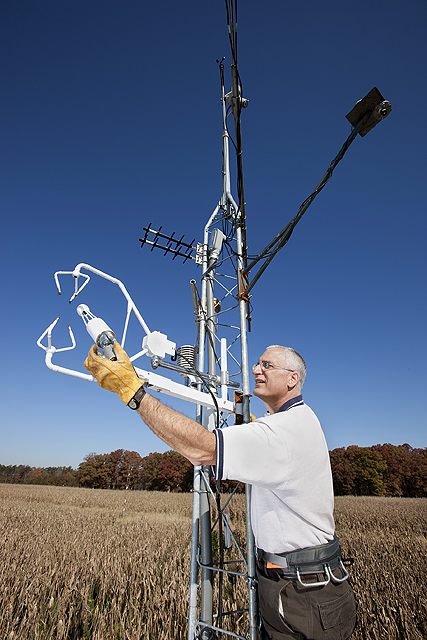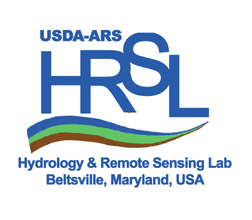| William Kustas |

|
 |
William P. Kustas, Ph.D. Research Hydrologist USDA-ARS Hydrology and Remote Sensing Laboratory Bldg. 007, Rm. 104, BARC-West Beltsville, MD 20705-2350 USA Voice: (301) 504-8498 Fax: (301) 504-8931 Bill.Kustas@usda.gov |
Research Interests: (click here to see a list of current research projects)
- Modeling radiation and turbulent energy flux exchange across the soil-vegetation-atmosphere interface.
- Remote sensing-based models for evapotranspiration estimation over complex landscapes.
- Develop synergistic techniques that combine optical and microwave remote sensing for computing land surface fluxes.
Education:
- 1981 B.S. (Forest Engineering) State University of New York College of Environmental Science and Forestry, Syracuse, NY.
- 1983 M.S. (Hydrology and Hydraulics) School of Civil and Environmental Engineering, Cornell University, Ithaca, NY.
- 1986 Ph.D. (Hydrology and Atmospheric Sciences) School of Civil and Environmental Engineering, Cornell University, Ithaca, NY.
Professional Experience:
- 1986 - 2007: Research Hydrologist, USDA-ARS Hydrology and Remote Sensing Laboratory, Beltsville, MD.
- 2007 - 2013: Supervisory Research Hydrologist (Research Leader), USDA-ARS Hydrology and Remote Sensing Laboratory, Beltsville, MD.
- 2014 - 2015: Research Hydrologist, USDA-ARS Hydrology and Remote Sensing Laboratory, Beltsville, MD.
- 2015 - present: Distinguished Senior Research Scientist, USDA-ARS Hydrology and Remote Sensing Laboratory, Beltsville, MD.
Honors and Awards:
- Fellow of the American Geophysical Union for "Pioneering leadership in large-scale experiments and analysis of land-surface atmosphere interactions", 2003.
- Fellow of the American Meteorological Society for "Major accomplishments and contributions to the atmospheric and hydrologic sciences", 2009.
- USDA-ARS Beltsville Area Scientist of the Year, 2009.
- American Meteorological Society Award for Outstanding Achievement in Biometeorology, 2011.
- Promotion to Distinguished Senior Research Scientist, 2015.
- Recipient of the American Geophysical Union Hydrologic Sciences Award for outstanding contributions to the Science of Hydrology over a career, with an emphasis on the past five years, 2019.
- USDA-ARS Science Hall of Fame Inductee "For pioneering research in the theory and application of remote sensing for soil-plant-atmosphere modeling and plant water use in agroecosystems", 2021.
- Presidential Rank Award "For pioneering work in the application of remote sensing technology for determining crop water use and stress reaping tremendous benefits to agriculture and water management worldwide", 2023.
- American Meteorological Society Hydrologic Sciences Medal "For foundational advances in the measurement and theory of evapotranspiration, thoroughly examining climate and hydrologic sciences and their bridges to water resources management", 2024.
Committee Memberships and Offices held in AMS and other Scientific Organizations:
- American Meteorological Society (AMS) Committee on Hydrology, 1989-1996.
- Chair, AMS Committee on Hydrology, 1995-1996.
- AMS Conference Organizer, Conference on Hydrology, 1995.
- American Geophysical Union (AGU) Hydrology Section Executive Committee, 1994-1998.
- AGU Spring Program Chair, 1994-1996.
- AGU Remote Sensing Committee, 1990-present.
- Chair, AGU Remote Sensing Committee 1996-1998.
- AGU Special Session Convener, 1993, 1995, 1996-1998, 2003-2008.
- EOS Physical Climate and Hydrology Panel, 1994-2000.
- World Meteorological Organization’s (WMO) Commission for Hydrology Member, 1994-2000.
- Associate Rapporteur of the WMO Commission for Hydrology, 1995-1999.
- Member of CASES (Cooperative Atmosphere -Surface Exchange Study) project organized by National Oceanic and Atmospheric Administration, 1995-1998.
- Panel Member to IAHS Workshop Use of Remotely Sensed Data for the Estimation of Evapotranspiration, 1995.
- NASA Review Panel Member for the Land Surface Hydrology Program, 1999.
- International Scientific Committee Member for the 2nd International Conference on Environment-Water, 1999.
- Committee Member for the Anheuser Busch Coastal Research Center, 2000.
- Committee Member for "Validation of Hydrologic Remote Sensing" Workshop for Consortium of Universities for the Advancement of Hydrologic Sciences, 2004.
- Publications Steering Committee for IAHS Prediction of Ungaged Basins (PUB), 2007.
- Deputy Chair of the AGU Hydrology Section Large Scale Field Experiment Committee, 2008-2010.
- Co-Chair of the Scientific Steering Committee and Co-Convener of The International Conference on Land Surface Radiation and Energy Budgets: Observations, Modeling and Analysis, 2009.
- International Association of Hydrological Sciences (IAHS) Member of the Technical and Scientific Steering Committee for Remote Sensing and Hydrology 2010 Symposium.
- Scientific Steering and Planning Committee for the NASA/USDA Workshop on "Evapotranspiration: An Essential Observation for Climate Understanding and Efficient Water Management", 2011.
- Scientific Advisory Committee of Earth Observation for Water Cycle Science, European Space Agency, 2014-2015.
- Committee member of the GEWEX-SoilWat Initiative, 2016-2018.
- Team member of international consortium of remote sensing scientists for the Thermal Monitoring Advanced eXplorer (TMAX) project proposed to the European Space Agency Earth Observation Envelope Program, 2018-2019.
- Committee member of the International Group on Earth Observations Validation of Land Products and the Global Temperature working group, 2019.
Editorial Appointments:
- AGU Water Resources Research Associate Editor 2002-2005.
- AMS Board of the Journal of Hydrometeorology, Chief editor 2004-2007.
- Advances in Water Resources Editorial Board, 2004-present.
- Editorial Committee for the International Association of Hydrological Sciences (IAHS) Remote Sensing and Hydrology 2000 Symposium Red Book Publication.
- Editorial Committee for the International Association of Hydrological Sciences (IAHS) Remote Sensing and Hydrology 2010 Symposium Red Book Publication.
- Editorial Committee for the Hydrology and Earth System Sciences Journal Special Issue on Earth Observation Water Cycle Science Conference, 2010.
- Guest Editor for the Special Annual Review Issue for the Hydrological Processes Journal entitled "The role of remote sensing observations and models in hydrology: the science of evapotranspiration", 2011.
- Associate Editor of AGU Book Monograph from Chapman Conference entitled "Remote Sensing of the Terrestrial Water Cycle", 2012-2014.
- Guest Editor for the Agricultural and Forest Meteorology Special Issue on Partitioning the Sources of Evapotranspiration: Modeling, Measurements, and Instrumentation 2017-2018.
- Guest Editor for Irrigation Science Special Issue on the Grape Remote sensing Atmospheric Profile and Evapotranspiration eXperiment (GRAPEX) 2017-2019.
- Guest Editor for the International Association of Hydrological Sciences Remote Sensing and Hydrology Symposium Proceedings 2018-2019.
- Guest Editor for Irrigation Science Special Issue II on the Grape Remote sensing Atmospheric Profile and Evapotranspiration eXperiment (GRAPEX) 2020-2022.
Contributions, Impact and Stature:
Dr. Kustas has over 400 scientific publications of which 290 appear in peer-reviewed journals. The ISI Web of Science and Google Scholar citation reports compute an h-index of 80 and 100 with ~23,650and 37,860 citations, respectively, placing him in the top 1% of his peers in remote sensing and hydrology. The quality and significance of Dr. Kustas’ contributions to remote sensing research are cited in Scientometrics (96:203-209, 2013) where a bibliometric analysis ranked him 5th most productive out of the top 20 remote sensing authors world-wide. In 2022, a comprehensive citation report by Stanford University scientists ranks Dr. Kustas 48th out of 57,328 scientists in the same field. He has mentored 30 postdoctoral and visiting scientists and 10 M.S. and 14 PhD students. He currently serves on 2 PhD and 1 MS committees and supervises and mentors 2 postdocs. He has been awarded research grants from NASA and USDA totaling nearly $5 million in support for his research, particularly leading large-scale multidisciplinary experiments selected through peer-review. A key component of these projects was the leadership of large interdisciplinary teams. As principal investigator (PI)/Co-PI, Dr. Kustas designed and coordinated large scale interdisciplinary remote sensing field experiments supported by NASA/USDA in Arizona (Monsoon 90), Oklahoma (Washita 92, Washita 94, SGP 97, SGP 99, CLASIC07), Iowa (SMACEX/SMEX02), Texas (BEAREX08), and California (GRAPEX). The resulting research has made break-through contributions to basin and regional hydrologic and atmospheric modeling using remote sensing. Dr. Kustas’ international eminence in satellite remote sensing is evident by the fact his remote sensing model is now being implemented as a plugin via the SEN-ET toolbox in the European Space Agency’s (ESA’s) Sentinel Application Platform (SNAP). SNAP is the primary platform for producing ESA’s remote sensing data products generating global ET, soil moisture and other important environmental products. His model has been selected and used in the toolbox developed by ESA principal investigators for projects sponsored by nearly every nation with an Earth satellite program.
Publication Databases:
Outreach:

- Meet the Beltsville Distinguished Senior Research Scientists: https://www.ars.usda.gov/northeast-area/beltsville-md-barc/beltsville-agricultural-research-center/docs/meet-ba-st/
- Bill Kustas: Advancing Water Research Drop by Drop | NASA Applied Sciences: https://appliedsciences.nasa.gov/our-impact/people/bill-kustas-advancing-water-research-drop-drop
- This USDA scientist does work that is down to earth: https://federalnewsnetwork.com/people/2024/01/this-usda-scientist-does-work-that-is-down-to-earth/
- The amazing public servants the public doesn't know: https://federalnewsnetwork.com/federal-report/2023/12/the-amazing-public-servants-the-public-doesnt-know/

